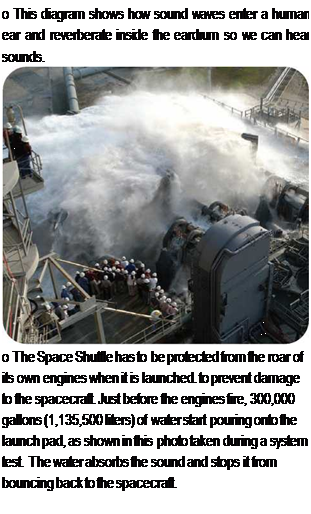Sound Wave
|
S |
ound is a form of energy that travels through the air as a series of pressure waves. The waves’ effect on the ear produces the sensation of hearing.
Anything that vibrates produces sound waves that spread out through the air. When something vibrates, it pushes against the air next to it and squashes the air. This pressure creates a pulse
MEASURING SOUND
The frequency of a sound is measured in hertz (abbreviated as Hz).
One hertz is equal to one compression per second. The human ear can hear sounds ranging in frequency from about 20 hertz to 20,000 hertz. Sounds below 20 hertz are called infrasound, and sounds above 20,000 hertz are called ultrasound.
Sound intensity is measured in units called decibels (abbreviated as dB). The quietest sound that can be heard has an intensity of 0 decibels.
A sound ten times more intense is 10 decibels. A sound 100 times more intense is 20 decibels. A sound 1,000 times more intense is 30 decibels. A whisper is about 20 decibels, while a jet engine 100 feet (30 meters) away is about 150 decibels.
_____________________________________________ /
that travels away through the air. After pushing against the air, the object pulls back again before the next push. When it pulls back, it creates a region of low pressure in the air. These high – pressure pulses are called compressions, and the low-pressure regions between them are known as rarefactions. The sound waves they create are called longitudinal waves.
The distance between one compression and the next is a sound wavelength. The number of compressions that pass any point in a second is the sound’s frequency. A high-pitched whistling sound has a high frequency, or a lot of pulses per second. A deep rumbling sound has a low frequency. Frequency and wavelength are linked. As frequency increases, wavelengths get smaller.
Sound needs something to travel through. It can travel through liquids and solid materials as well as air and other gases, but it cannot travel through space without air. The speed of sound in air depends on how fast vibrations spread from molecule to molecule, and this depends on the temperature of the air. Sound travels faster in warm air than in cold air. On an average day, with an air temperature of about 59°F (15°C), the speed of sound in air is about 760 miles per hour (1,220 kilometers per hour).
Vibrations produce sound, but sound itself also can make things vibrate. We hear because sound waves enter our ears and make our eardrums vibrate. Every machine, and every part of a machine, has a resonant frequency at which it
Tympanic membrane (eardrum)
![]()


![]()
![]()

 ■ Sound waves
■ Sound waves
in liquid

vibrates very strongly. Engineers try to ensure that aircraft and their engines do not vibrate at their resonant frequency. This is because strong vibrations can cause damage, shake things loose, and make an aircraft very noisy.
Vibrating rotors and propellers can cause a lot of noise inside helicopters and propeller planes. The noise makes it difficult for pilots to hear messages in their radio headsets. To counteract this, pilots can wear headsets that remove unwanted sound by making more sound. The system listens to the background noise and instantly makes a copy of it with the compressions and rarefactions reversed. The compressions of one sound fill up the rarefactions of the other sound, and thus the two sounds cancel each other out.
——————————————— N
SEE ALSO:
• Air and Atmosphere • Communication • Energy • Pressure
______________________________________________ /










